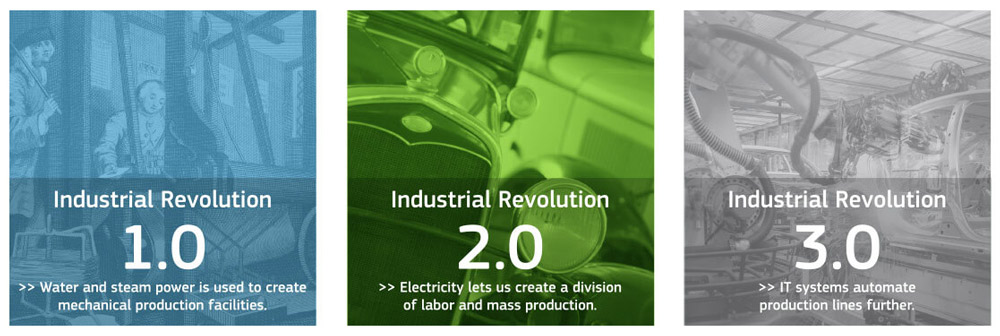History repeats itself. We know this is true. Over the last few hundred years, society’s massive evolution in technology and manufacturing processes has shaken up the way goods are produced and distributed across the world. Now that we’re standing squarely in Industry 4.0., the conversation on digitization, automation, and the present and future state of digital manufacturing is generating quite a buzz.
You know when you’re in a meeting and someone uses a trendy term incorrectly, and you think to yourself, “that doesn’t mean what I think they think it means?” We’ve all been there, on one side or the other. That’s because buzzwords are everywhere and like a large-scale game of telephone, their definitions can become murky over time.
To add clarity to some seemingly ambiguous Industry 4.0 terminology, we’ll unpack common phrases you might overhear people chatting about at the coffeeshop (or hotly debating on social media). We’ll demystify what they mean and how they relate to the world’s current and ever-evolving Fourth Industrial Revolution (4IR).
How it Started vs. How it’s Going
Before we examine where we’re at right now—smack dab in the middle of Industry 4.0—here’s a quick refresher on the previous three Industrial Revolutions the world has undergone since the 18th century:
- Industry 1.0 (Late 1700s). Steam and water power spark manufacturing mechanization
- Industry 2.0 (Late 1800s). Electrical power allows for mass production (a la assembly line)
- Industry 3.0 (Late 1900s). Automated production thanks to electronics and computers

A snapshot of the three preceding Industrial Revolutions.
What is Industry 4.0?
4IR is all about automation and information. Automation of processes, more readily available and trackable information throughout the manufacturing journey, increased efficiency and sustainability measures, and top-notch user experience. All are vital spokes in the wheel of Industry 4.0.
The automotive, aerospace, medical device, and consumer electronics industries require suppliers and partners that offer quality and speed. Manufacturers that refuse to embrace the latest and greatest 4IR technological advancements and process improvements are susceptible to falling behind, slowing down part production, and in turn, disappointing customers.

4IR Buzzwords Glossary
Now, let’s break down these trendy 4IR topics:
Advanced Industrial Robotics: Often used interchangeably with the term cobots, these computer-controlled robots perform repeated manual tasks. In digital manufacturing, these programmed machines allow for optimal efficiency, lessening the likelihood of human error and optimizing repetitive assembly line tasks. We’re happy to have a handful of impressive cobots throughout our manufacturing plants that work in tandem with human counterparts and add another layer of consistency in part processing. Robots and cobots aren’t expected to replace people in manufacturing. Rather, humans are essential to enable these machines and work together.
Digital Manufacturing: Shared data drives the entire product life cycle, from design upload to manufacturing, and quality control practices, to finished part. This streamlined process leads to lower costs, quicker turnarounds, and improved part quality. Digital manufacturing is what we do!
Digital Thread: The transparent end-to-end digital process from software-driven design upload and manufacturability analysis, through automated manufacturing. This interconnected digitization eliminates silos of information that have long hampered data exchange between disparate software systems, tying together each aspect of the manufacturing process. The seamless digital thread of information is the byproduct of digital manufacturing.

Digital Twin: A virtual designed copy of a physical object. Thanks to simulated digital twins, we can visualize and determine important specs, like how to orient a part in the mold, what tools to use to make the mold, the paths the tools will take, and more. With digital manufacturing, mistakes can be caught in the digital twin, helping to save on manufacturing time, lower costs, and ensure on-time delivery.
Eco-efficiency: The harmony between economic and environmental sustainability. In a nutshell, achieving eco-efficiency is achieved by creating a higher volume of goods while reducing waste and pollution. Companies that embrace 4IR principles have eco-efficiency measures at the forefront of their processes. Our injection molding facility has been recognized for our sustainability efforts thanks to our 1,900 solar panels that help fuel it.
Industrial Internet of Things (IIoT): Physical objects with embedded software, (i.e., smart devices like wearable fitness trackers and self-driving cars) that collect and report data, make decisions, and keep humans informed of potential problems. The industrial IoT and cloud stored data therein are key aspects of the importance of reporting, tracking, and enhancing quality processes in the future of Industry 4.0.
On-Demand Manufacturing (ODM): This one’s straightforward. Parts when you need them. At Protolabs, this option tends to work best for those who have steady low-volume production needs that are beyond prototyping, and it helps companies that prefer not to keep large part inventories, too.
Supply Chain Management: The pandemic sparked worldwide supply-related issues. Businesses facing supply chain disruption have had to become agile in finding suppliers that can meet their manufacturing needs. Enter digital manufacturers—like yours truly!
Our current industrial revolution is rapidly unfolding and changing in real-time. Sticking with trusted 4IR-fueled suppliers provides critical speed, built-in data tracking and quality reporting via the digital thread, and the peace of mind that comes from agile automation.









